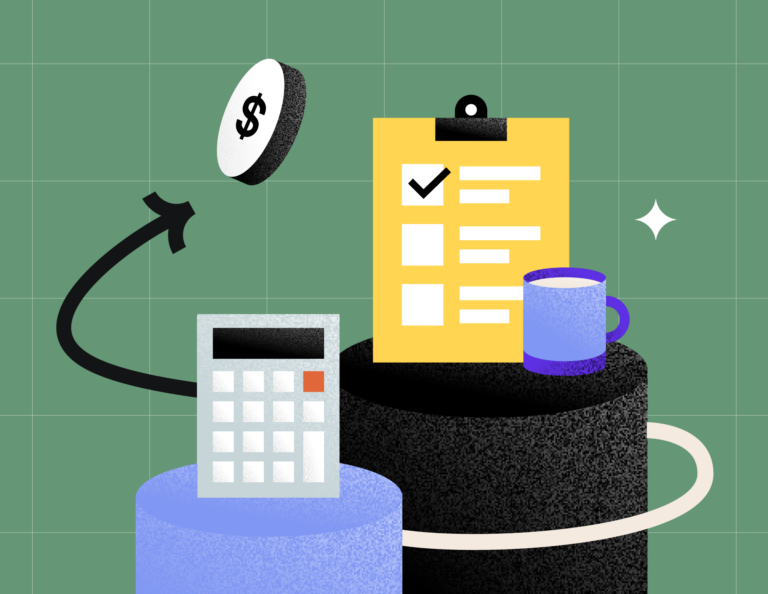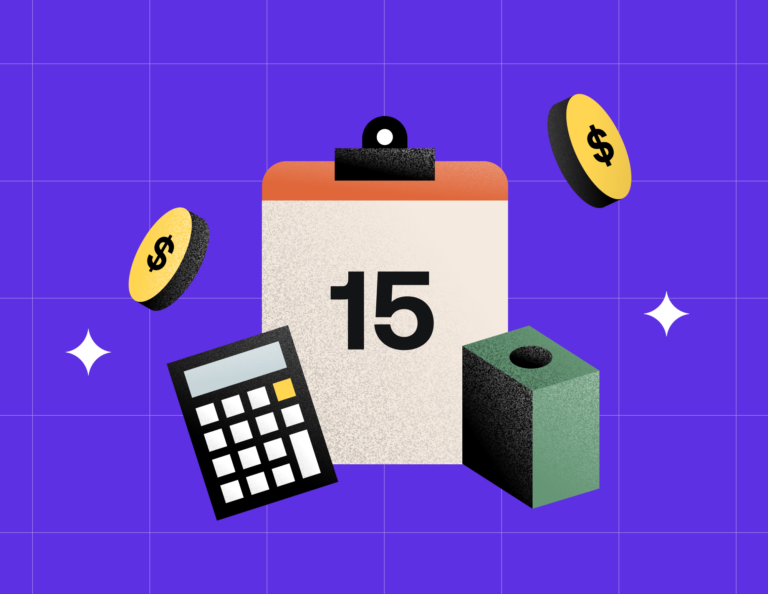Positive cash flow can be a tricky concept to master, but learning how to manage it well ensures you’ll have the cash on hand to operate in the green.

Your cash flow plays a big part in your financial management, day-to-day business operations, and overall business health. Beyond tracking your expenses and earnings, understanding your cash flow can help you chart a course to growing and scaling your business.
After managing your expenses, you might notice that your business’ profit (revenue after costs) may be different than what’s in your bank account. Often times this is due to a negative or positive cash flow. With money moving in and out all the time, here’s how to better understand cash flow and control it.
Jump to:
- Definition of cash flow
- What’s the difference between cash flow and profit & loss statements?
- A real-life example of cash flow
- How to maintain positive cash flow
- Expertly manage your cash flow
Definition of cash flow
By definition, cash flow is the status of the total cash minus expenses flowing into and out of your account at any point in time. For example, if you’re spending more money than you have on hand, you’ll have a negative cash flow.
Cash flow is a complicated concept because as business owners, there’s a lot of money we spend and make on a daily basis. One day you’ll have a positive cash flow, but you might pay a few bills the next day and your cash flow is in the red.
The three types of cash flow
There are three types of cash flow to understand: operational, investment, and financing. They can be a touch confusing because many financial terms overlap, but we’ll make it clear which is which.
Operational cash flow
Operating cash flow is the most important, and the one you’ll pay attention to the most as a small business owner. Your operating cash flow considers cash received and spent related to your primary activities. So, if you’re a business coach, your operating inflows would be from your client’s payments, while your operating outflows would likely be from advertising and marketing costs and technology to run your coaching business.
Investment cash flow
Your investment cash flow is tied to any investment made for long-term benefits. This can include interest you’ve made or made, loan payment (outflow), or profit from selling your office space (inflow).
Pro Tip: Interest accrued on a high-yield business savings account counts as investment cash flow.
Finance cash flow
Lastly, cash flow from financing is the money you make and lose on activities related to funding your company. If you were to use a family loan and invest that into your company, and you promised to pay the loaner interest for a set amount of time, that would be considered finance cash flow.
Similarly, if the loaner then owned a portion of your independent business rather than expecting repayment, and you decided to buy their portion back, that would be considered finance cash flow as well.
What’s the difference between cash flow and profit & loss statements?
It’s normal that your profit and loss statement doesn’t always match what’s in your bank account. A profit & loss, or P&L statement, is different from cash flow because the profit and loss statement accounts for revenue made over a period of time while cash flow accounts for a point in time.
Pro tip
Think of your cash flow as a snapshot of your business as it stands today and your P&L as revenue made over a given period of time.
Think of your cash flow as a snapshot of your business as it stands today and your profit and loss statement as a time-lapse video from a moment you want to recall key details from.
Typically, the best way to interpret cash flow is by converting it into a cash flow statement. If you are using the QuickBooks integration with HoneyBook, your QuickBooks software can create a cash flow statement for you. Using your cash flow statement, you can identify your operating expenses and activities, investment activity, and cash flow from financing. When you work with an accountant, they’ll pull your cash flow statement along with a balance sheet and income statement to understand your business’s financial health.

A real-life example of cash flow
Let’s look at an example of a cash flow discrepancy for freelancers. Let’s say you’re a photographer and you’ve booked a $1,000 gig for the end of the month. You charge a $200 deposit at booking at the beginning of the month, but you have to spend $300 in the middle of the month for supplies. After the gig at the end of the month, you receive the remaining balance of $800. Although your net income may be positive $700 ($1,000 gig less $300 expenses) by the end of the gig, at one point you had a negative cash flow of $100 ($200 deposit less $300 for supplies).
Even with this easy example, we can see how a business could see a discrepancy in cash on hand versus what is reported in your P&L statement. Although we can’t completely eradicate cash flow issues in business, we can find ways to keep a positive cash flow by updating our payment terms, cost of goods sold, and how we handle late payments.
How to maintain positive cash flow
There are ways you can optimize the backend of your clientflow to maintain a positive cash flow. If you have clientflow management software for small businesses like HoneyBook, it can help you facilitate each of these methods that will keep your cash flow in the green.
Update your payment terms
One reason why entrepreneurs have a negative cash flow throughout a client cycle is that their payment terms don’t cover the expenses necessary during the client journey. An independent business owner’s goal is to get paid 100% upfront, but some clients require Net 30, 60, or even 90-day payments.
Pro tip
A retainer fee is a fee paid upfront to an independent service provider to secure services.
To counteract a mid-client journey cash shortage, consider always negotiating your payment terms. If a client asks for Net 30 payment terms, ask for something smaller like Net 15. You might also be able to offer your client a small 2% to 5% discount in exchange for a shorter payment term.
You can also increase your retainer to cover all costs of goods sold. This may not be possible, but for independent business owners with low overhead costs, it’s a possibility.
Your goal is to ensure that you can get paid to keep your bank accounts in the black! A HoneyBook’s online invoicing automation can help you find and communicate the best payment terms for you.

Cost of Goods Sold
Cost of goods sold is the cost directly associated with selling your goods and services. Independents are often forced to pay these costs prior to being paid because of things like net payment terms or high cost of goods sold for operation.
To maintain your positive cash flow, try to keep your costs of goods sold as low as possible. Buy supplies and packaging in bulk or source inexpensive alternatives. You can also try to purchase any common cost of goods sold items when you have the most cash on hand.
Late Payments
If you’re an independent business owner, chances are you’ve had your fair share of late payments. Not only are late payments a nuisance, but they can also really affect your cash flow and put you dangerously in debt if you can’t recoup the revenue. With HoneyBook, reducing late payments is easy. Use HoneyBook’s online contract tool to send automatic payment reminders. With HoneyBook’s online contract tool you can also:
- Implement Late Fees – Late fees are an easy way to deter late payers. Late fees can be as simple as a flat fee or as dynamic as a percentage-based fee that compounds over time. Not only will it help reduce the number of late payments you receive, but you also can make additional revenue if those invoices are in fact late.
- Create Installment or Payment Plans – Customers may be more likely to pay on time when the payments are spread out. Payment intallments help your cash flow because you see a steady stream of income. Ideally, these payments cover any costs you incur throughout the delivery of the product or service.
- Require Automatic Payments – You can guarantee on-time payments with a system that sets up recurring payments and an automatic payment reminder.
- Refunds – As you know, refunds can be incredibly detrimental to both your net income and positive cash flow. If you are not implementing non-refundable retainers, I’d highly suggest implementing one as soon as you can. You can update your online contracts to specify your refund policy and even include clauses like force majeure to help protect your business from unexpected cancellations. Additionally, consider opting for percentage-based non-refundable retainers that cover your cost of goods sold. If your cost of goods sold is 30% per product or service, a 30% non-refundable retainer can cover costs if your customer requests a refund.
These are great business practices and ways to keep your cash flow positive so you can continue to operate.
Expertly manage your cash flow
Cash flow is a tricky concept but managing it on your own is easy once you implement the right tools. First, make sure you have an all-in-one clientflow management platform for your business so you can track client payments and expenses in one place. Holding all your business financial information in a single system will help you stay more organized to have a better understanding of your cash flow.
You can always work with a professional accountant to make sure your business finances are set up properly and tracked correctly. Once you have a grasp on your cash flow, you’ll be on the road to great profitability and growth!

Easily keep track of all your clients and projects using HoneyBook.



